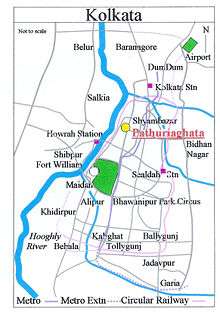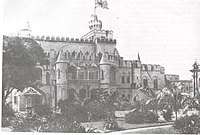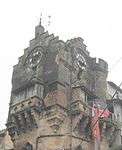Pathuriaghata
Pathuriaghata is a neighbourhood of North Kolkata in Kolkata district, in the Indian state of West Bengal. It is one of the oldest residential areas in what was Sutanuti. Once the abode of the Bengali rich, the neighbourhood and its surrounding areas are now dominated by Marwaris. Even in the 21st century the area is replete with colonnaded mansions.
Pathuriaghata | |
|---|---|
Neighbourhood in Kolkata (Calcutta) | |
 Pathuriaghata Street | |
 | |
| Coordinates: 22.5895°N 88.3548°E | |
| Country | |
| State | West Bengal |
| City | Kolkata |
| District | Kolkata |
| Metro Station | Girish Park and Sobhabazar Sutanuti |
| Municipal Corporation | Kolkata Municipal Corporation |
| KMC ward | 24 |
| Elevation | 36 ft (11 m) |
| Population | |
| • Total | For population see linked KMC ward page |
| Time zone | UTC+5:30 (IST) |
| PIN | 700006 |
| Area code(s) | +91 33 |
| Lok Sabha constituency | Kolkata Uttar |
| Vidhan Sabha constituency | Shyampukur |
The Tagores
Amongst the oldest and most renowned residents of the neighbourhood were the Tagores. Joyram Tagore, who amassed a large fortune as a merchant and as Dewan to the French government at Chandannagar, shifted from Gobindapur to Pathuriaghata, when the British constructed new Fort William in the mid-eighteenth century. There is a road named after his son, Darpanarayan Tagore (1731-1793), considered by many as the founder of the Tagore family. It is between Maharshi Debendra Road and Jadulal Mullick Road in Ward 21 of Kolkata Municipal Corporation. That is just off Pathuriaghata, but under Jorabagan police station.[1][2] The Tagore family established themselves at Pathuriaghata, Jorasanko, Kailahata and Chorbagan, all neighbourhoods in north Kolkata.[3]
The more prominent amongst those who stayed in Pathuriaghata were Hara Kumar Tagore (1798-1858), Prasanna Kumar Tagore (1801-1886), Jatindramohan Tagore (1831 – 1908) and Prodyot Coomar Tagore (1873 - 1942). Prasanna Kumar Tagore built a huge mansion in Naptehata and named it ‘Palace’. People used to call it ‘Tagore Palace’. What was once Naptehata is now Prasanna Kumar Tagore Street. ‘Tagore Palace’ occupies house numbers 13, 13A and 13 B of this street. The more prominent house is ‘Tagore Castle’ at 26 Prasanna Kumar Tagore Street. Jatindramohan Tagore had made a departure in the way of building residences in India. He modelled the building on that of an English castle. It even had a 100 feet (30 m) high centre tower in the fashion of Windsor Castle in England. There was a clock imported from England, reminiscent of Big Ben. He even had permission to fly the Union Jack. In 1954, S.B. House and Land Pvt. Ltd. of Haridas Mundhra took over the building and has altered most of it to beyond recognition.[4] Currently Kunj Bihari Aggarwal is the resident.
 |
Banga Natyalaya
‘Tagore Castle’ had an auditorium and the Tagores patronised Banga Natyalay, from 1859 to 1872. It was started by Jatindra Mohan Tagore and his brother Shourendra Mohan Tagore, both ardent theatre enthusiasts. The first play staged here was Kalidas’ Mālavikāgnimitram in Sanskrit, in July 1859.[5]
Sambad Prabhakar
Jogendra Mohan Tagore of Pathuriaghata, helped Ishwar Chandra Gupta to publish Sambad Prabhakar, first as a weekly from 28 January 1831. After passing through vicissitudes, it became a daily and played an important role in forming modern Bengali society.[6]
The Mullick family
Next to the turrets of Tagore Castle on Prasanna Kumar Tagore Street is the house of the Mullick family topped by classical statuary. Three large structures have already come up next to these, one of them is the Burrabazar branch of Metropolitan School, established in 1887.[7] Jadulal Mullick (1844-1894) had numerous contributions in social and law spheres. At one time he donated enormously to the Oriental Seminary from where he had passed Entrance, school-leaving examination.[8] Jadulal Mullick has a road named after him in the area. His son, Manmathanath Mullick, bought a pair of zebras from Alipore Zoological Gardens to pull his carriage through the streets of Kolkata. He had nine types of carriages and a stable full of horses. One of the grandsons of Jadulal Mullick, Prodyunno Kumar Mullick had 35 cars, out of which 10 were Rolls Royce. The Mullicks have contributed enormously for charitable purposes.[9] The courtyard of Jadulal Mullick's house has intricate cast iron works, one of the finest in Kolkata.
The Ghosh family
The Ghosh family came to Pathuriaghata from Keshpur at the time of Warren Hastings. It is said that Warren Hastings and his wife visited the Ghosh family.[10] Khelat Chandra Ghosh (1829-1878), grandson of Hasting’s banyan (clerk) Ramlochan Ghosh, moved out of the old family house at 46 Pathuriaghata Street to a new house at 47 Pathuriaghata Street. The family made a substantial contribution in music and charity. There is a lane named after him in Ward No. 24 (not shown in the map alongside). The lineage at 47 Pathuriaghata Street was Babu Khelat Ghosh, Babu Romanath Ghosh, Babu Siddheswar Ghosh (who patronized the famous Author Bibhuti Bhushan Bandopadhyay) and his brother Babu Aukhoy Ghosh. Presently the All Bengal Music Conference is held at 47 Pathuriaghata Street and is patronized by Babu Pradeep Ghosh [11] This mansion is filled with marble sculptures, paintings, crystal chandeliers and other art objects. In the year 1849, Raycharan Ghosh (zamindar) moved out of Kolkata and thus another family tree of the Ghosh family found lineage. His son Upendranath Ghosh was the Attorney General for the Awadh district under the British India Empire. Upendranath's first son Lalit Kumar Ghosh unified the families back and constructed a mansion near Rashbehari Avenue in Kolkata and wanted to keep one of the oldest Durga Puja traditions in Kolkata alive by entrusting the sons of the family with the responsibility.
In the halls of the Ghose family at 46 Pathuriaghata Street, the All Bengal Music Conference was founded in 1937. Indian classical music was then a nascent art form; only baijis (courtesans) sang publicly. Manmathanath Ghose (1908 – 1983) was the first patron to invite Hirabai Barodekar, a legendary musician, to the inner wing of his home, despite the protests of his wife. He considered it his honour to host talent, and the legendary sitar maestro Ravi Shankar met his guru Allauddin Khan there. The Durga Puja and its traditions continue to be followed by the current members of the family.[12]
Culture
The Pathuriaghata Bayam Samity, the branch of 'Anushilan Samity" established by famous freedom fighter Jatindranath Mukherjee (Bagha Jatin) is situated here. The Samity arranged the first Kali Puja of Kolkata.
Pathuriaghata picture gallery
 The Burrabazar branch of the Metropolitan Institution
The Burrabazar branch of the Metropolitan Institution Tagore Castle in 1907
Tagore Castle in 1907 A portion of what remains of Tagore Castle
A portion of what remains of Tagore Castle Pathuriaghata Street, Kolkata, India
Pathuriaghata Street, Kolkata, India
References
- Cotton, H.E.A., Calcutta Old and New, 1909/1980, p. 293, General Printers and Publishers Pvt. Ltd.
- Map no. 13, Detail Maps of 141 Wards of Kolkata, D.R.Publication and Sales Concern, 66 College Street, Kolkata – 700073
- Deb, Chitra, Jorasanko and the Thakur Family, in Calcutta, the Living City, Vol I, edited by Sukanta Chaudhuri, p 65, Oxford University Press, ISBN 0-19-563696-1
- Bandopadhyay, Debashis, Bonedi Kolkatar Gharbari, (in Bengali), Second impression 2002, pp. 113-6, Ananda Publishers, ISBN 81-7756-158-8
- Mukhopadhyay, Ganesh (2012). "Theatre Stage". In Islam, Sirajul; Jamal, Ahmed A. (eds.). Banglapedia: National Encyclopedia of Bangladesh (Second ed.). Asiatic Society of Bangladesh.
- Kahaly, Anirudha (2012). "Gupta, Ishwar Chandra". In Islam, Sirajul; Jamal, Ahmed A. (eds.). Banglapedia: National Encyclopedia of Bangladesh (Second ed.). Asiatic Society of Bangladesh.
- Das, Soumitra. "Character Assassination". The Telegraph, 8 April 2007. Retrieved 15 July 2007.
- Sengupta, Subodh Chandra and Bose, Anjali (editors), 1976/1998, Sansad Bangali Charitabhidhan (Biographical dictionary) Vol I, (in Bengali), p. 437, ISBN 81-85626-65-0
- Bandopadhyay, Debashis, pp. 19-21, Ananda Publishers, ISBN 81-7756-158-8
- "Clay Images of West Bengal". Calcutta Notes. clayimage.co.uk. Archived from the original on 3 July 2007. Retrieved 15 July 2007.
- Bandopadhyay, Debashis, pp. 30-1, Ananda Publishers, ISBN 81-7756-158-8
- "The Kolkata Network". Kolkata Through Adwaitya's Eyes. Ryze Business Networking. Retrieved 15 July 2007.
External links
![]()